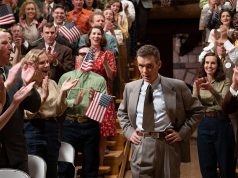If anyone knows how to fill a screen, it’s Christopher Nolan.
And he doesn’t just load it up with fantastic imagery but he packs in all this emotion and enhances them with fantastic music and sound design.
In “Dunkirk,” Christopher Nolan is at the top of his game, marrying all the cinematic elements together to tell the riveting story of the evacuation of British forces in the French coastal city of Dunkirk during World War II.
It is the simplest of plots: the British and French soldiers in Dunkirk are pinned by the coming German army and they have to escape or they will die. The British military forces are spread thin and while they need their army, they cannot afford to rescue the troops at Dunkirk for fear of leaving Britain defenseless.
As Nolan has done in previous films like “Memento,” “Inception,” and “Interstellar,” he cinematically bends time to present three separate narratives — on land, sea, and air — which all happens simultaneously on screen but plays out in different spans of time.
It’s an amazing directorial feat using lighting, editing, and music to bridge these narratives and tie up losoe ends so that when the film reaches its conclusion, everything comes together.
Threading these stories together is the music of Hans Zimmer, playing variations from the timer of a watch, he suffuses each scene with tension and dread, the ticking of the clock a constant reminder that death is just a gun shot or a bomb blast away and it creates a constant, relentless atmosphere of tension. It never ends from the moment the movie begins until it ends.
Written by Nolan, the film is almost without dialogue, and everything is told through grand imagery. The mass of soldiers waiting at the beach, black smoke in the distance reminding us that the enemy is near, the empty sky as the fighter planes rush to Dunkirk, and the open sea.
Without unnecessary drama, Nolan tells this story through raw emotion, simply emphasizing the need for the soldiers to get out of Dunkirk and the rush of the people back home to get there to try and save the soldiers from certain death.
This is the best example one can give on the artistic conceit of “showing and not telling,” where the significance of this moment is highlighted in each character’s desperate need to survive. There is no need for verbosity or explanation. You can see it in what the characters do and how they react to the events that transpire.
It is unbelievably simple, if you take down “Dunkirk” to its core, but what Christopher Nolan does is emphasize the cinematic qualities of the story and, through large crowd scenes, grand images of war and destruction, epic music with the theme of the ticking of the clock, and juxtaposition of the soldiers in Dunkirk trying to escape against the people of Britain trying to rescue them — the film can do away with any individual backstory or any real character development.
This moment in history is the story. And there’s such great confidence in Christopher Nolan to recognize that he didn’t need to ground it in any one individual’s story or story arc.
Despite an amazing cast of renowned and acclaimed actors and virtual unknowns, the true stars of this movie are really Christopher Nolan and Hans Zimmer.
The film does boast of an acclaimed cast that includes Academy Award winner Mark Rylance and Academy Award nominees Tom Hardy and Kenneth Branagh. It boasts of familiar faces like Christopher Nolan regular Cillian Murphy and virtually unknown actors like Fionn Whitehead, Barry Keoghan, Jack Lowden, and One Direction member Harry Styles. But they are merely players in this grand example of cinema.
It’s as if all of Nolan’s work prior to this, all great and enjoyable movies on their own, were really just practice for him to get “Dunkirk” right. And he got it right.










